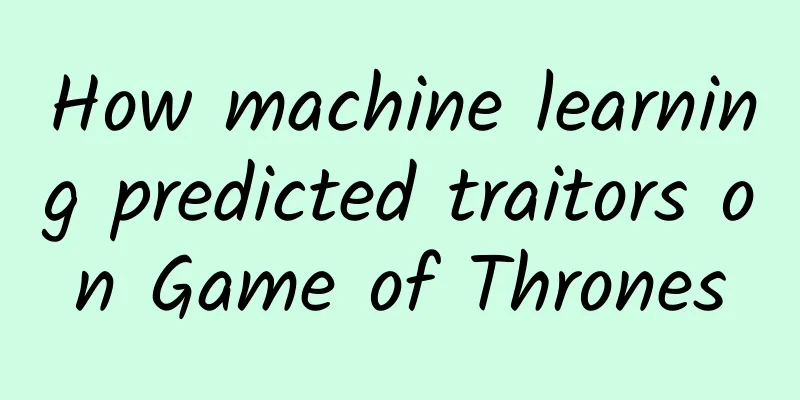How machine learning predicted traitors on Game of Thrones

Using predictive models for marketingThe key challenge in the predictive models our team develops for marketing is to predict over a specific time period. We are trying to find the precise time points behind the data that determine when consumers are willing to buy. We took inspiration from Airbnb and developed a machine learning model for the fictional characters in Game of Thrones, adding coefficients that reflect the difficulty of selling in the real world, so that we can grasp the precise time when consumers have the need to buy and respond in time. If you assume that a potential buyer is actually a resident of Westeros, and you blur the line between "good" and "evil", then you have to think carefully - everyone may be a traitor lurking around you at any time (you can also understand that he will buy your product). So how can you predict when they are going to defect (or buy out)? Our first challenge was to transform the data we needed for training - a list of various behaviors of people with different personality traits - into personality trait data that could be processed by the model. Then, we used these activity data that could represent their personal personality traits to make predictions about them. Behavioral scoring methodThere is a way to count the number of actions associated with a persona, which can be used to train our predictive model (similar to how marketing automation systems score leads). Unfortunately, this method does not help us distinguish whether an action happened in the past or in the present. This ability to distinguish is critical if we want to predict actions that will happen in the near future. From another perspective, we might only focus on recent activities. This does help us keep our data up to date and address the negative impact of old data on our evaluation. But what if a character hasn't done anything recently? We'll still evaluate him based on his past actions. And we'll still keep some of his recent historical activity data, because some seemingly one-off activities in the past can turn into a significant pattern and affect future decision making. We can benefit from a hybrid approach. For example, we can combine the past activities of the person in the model with the recent activities. In addition, we can use a series of different interface windows to treat recent activities differently. This way we can remember the actions that happened three weeks ago, but we can use different standards to measure the actions that happened yesterday. Tracking behavioral targets on the movePlease remember that the emotional state behind the character will change over time. The following chart reflects the historical changes in personality to see how the emotions behind the character's personality traits affect our prediction goals: You can see that in August, based on his recent behavior, our model thought he would defect (buy the product) during this period. Although this was expected, he remained loyal for several months. Of course, his defection did happen subconsciously. Since people's emotional state (whether they are ready to defect) changes over time, our model also needs to know whether someone is about to defect, so that we can know the exact time to strike back. Model evaluation thinking: scoring and re-scoring within a time seriesIn order to understand whether our model can accurately reflect the motivations of characters, each character should be attached with a reference score - we need to assess how trustworthy they are, and this reference score should be adjusted over time. But this will make our evaluation system very complicated, because our views on the "good" or "evil" of a character will change over time, just as the motivations of these characters' own behavior will also change over time. Another problem will arise when the scores stay at a peak before returning to a level. The spread of misleading predictions may make us temporarily skeptical of some extremely loyal characters, so we must ensure that the model's evaluation function is based on all scores over the entire period. When we retrain the model, we must penalize these incorrect scores and compare them to see which model is relatively better. To evaluate whether a model is performing well, we simply need to consider the score we get each time we evaluate a character (daily or weekly), and observe how well the model predicts their behavior the following week. If at the beginning of a week, we assert that a character is very likely to defect, and they defect on Thursday of that week, then our model is working well and is giving positive and correct recommendations. However, if this character still does not defect in the predicted week, but does not defect until Thursday of the following week, then our model's recommendation is wrong. In this case, we have to consider how to score this character the following week. Conclusion: What do we learn from this inspiration?From this hypothetical case, we can see that if you want to build an accurate behavior assessment model, you need a lot of sufficient thinking and experience, and you need to use the correct measurement method to determine the accuracy of the score. When the time span of machine learning is very long, it becomes particularly important to monitor the model and be careful about possible deviations. Always remember that if your model makes the same wrong judgment about the same person over and over again, then your model will face the end, and at the same time, it also indicates that your model needs to be updated. If you follow all the tips above, your behavioral scoring model will bring valuable machine learning to your business needs. Knowing what people do and when is the key to predictive success. |
<<: Apple launches new iPod Touch: starting at 1,495 yuan, is it worth buying?
>>: SEMI: Global semiconductor materials market output value reached US$43.4 billion in 2015
Recommend
Comparing the two years of Stanford AI reports: 32 charts to help you fully understand the development of the industry
The AI Index project of Stanford University'...
Bilibili is going public in the United States. Let’s talk about the “three-step” strategy for advertising on Bilibili!
Most marketers who are eager for a young user bas...
What is the zombie deer virus detected in Yellowstone National Park? | Expo Daily
Zombie deer virus detected in Yellowstone Nationa...
How to prevent the epidemic during the May Day holiday? Please take good care of yourself during this short holiday
Can we still travel during the May Day holiday? W...
The “white spots” that brought the cultural relics back to life are actually plaster?
When visiting museums, we often see a large numbe...
Is immunity testing really reliable?
Is immunity testing reliable? This is a hot topic...
How to build a core fan group for your live broadcast room?
Hundreds of fans can be seen in Li Jiaqi and Wei ...
RxJava Operator Series 3 (Part 1)
RxJava Operator Series Portal RxJava operator sou...
How will 360 search advertising promotion information be displayed and what are the conditions for displaying it?
How will my promotional information be displayed?...
What will happen to your body if you eat one sausage a day? Is it okay to eat a sausage that costs 2 yuan?
"Give me a sausage, thank you!" Image s...
Enrollment marketing strategy skills for educational institutions!
In 2020, due to the epidemic, the enrollment path...
Is it difficult to convert users into promotion? Catering to the fun point is the key
With the development of information flow advertis...
Exclusive interview with Umeng: Focusing on data services for the mobile development ecosystem
On December 9, Umeng released its new data strate...
Super complete and detailed! 4 important links of user operation!
The first thing to be clear is that the links of ...
WeChat teaches you how to set up a street stall: This score is your signboard
It seemed as if overnight, setting up stalls beca...









